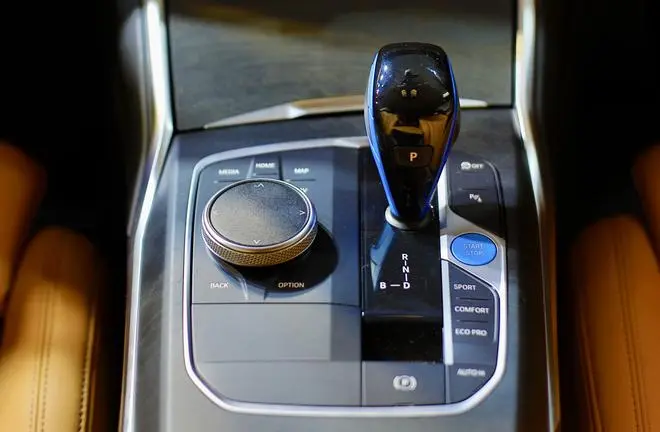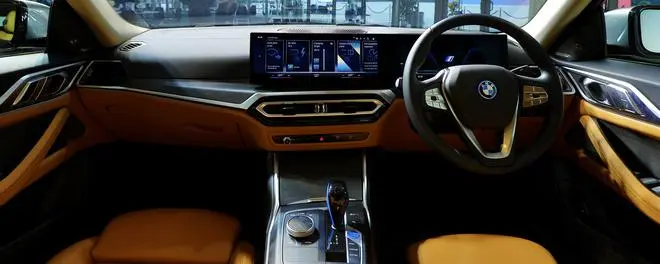BMW’s journey towards electrifying its portfolio has been hastened over the last few months both globally and in India. While the ‘BMWi’ division was set up and a few electrics rolled out in quick succession, there was a lull in between before the action has swung back in full-steam. And now we will be seeing a mix of both fresh BEVs sporting unconventional designs and ICE-based EVs, with relatively conventional designs bearing the BMW badge.
A few months ago, the iX landed on our shores and the next ‘i’ car to be plugged into the BMW portfolio is the i4. The sporty, coupe-sedan (BMW’s term is Gran-Coupe) looks stunning and has been launched at an equally stunning introductory price of ₹69.9 lakh, making it one of the most desirable electrics currently in the market. After the i8, this is one BMWi car that can be expected to set your pulse racing even before you hit that start button. So what does it feel like to be piloting the i4. Last week I headed to the ICAT track outside Gurugram to find out.
Design
The BMW i4 is the ICE-based, more conventional looking electric from the German luxury brand, from the perspective of how close it is, in terms of its looks, to a fast, sporty ICE vehicle from the portfolio. While that oversized kidney grille at the front does point to the more recent evolutionary position in the grid, the i4 could pass off as a BMW that’s powered by petrol rather than by Lithium. The side profile is the most flattering, with the roofline almost like that of a raised supercar.

The i4 is, of course, based on an ICE-architecture basically shared with the 3 Series, 4 Series, GranCoupe), but has the characteristics of a BEV under the skin. For one, its centre of gravity is lower by 53mm compared to the 3 Series sedan, thanks to the battery-pack located under the floor. The specific model variant that has been launched here and the one we are talking about is the BMW i4 eDrive40. Its wheelbase is nearly 2.9 metres long, and the wide front and rear tracks are actually more than the 3 Series by 26mm and 13mm, respectively.

The i4’s rear design is taut, with slimmer tail-lamps that still feature the L-shaped LED light signature. The stubby boot lid has a lip spoiler for better aerodynamics. And the rear fender features a vertical spoiler a recessed aero surfaces next to the diffuser. Obviously, there are no tail-pipes, though someone from the ICE-age (like yours truly), might still think it’d would’ve been nice touch. The alloy wheels are lightweight and designed to aid in the i4’s aerodynamics, as do the flip-up door handles and airvents. The frameless doors add to the sporty image of the i4.
Cabin
Getting behind the wheel of the i4 at the ICAT track, the overwhelming feeling is that I’m in the cabin of a ICE sedan. A lot of the features are very clearly shared platform parts or have been heavily influenced by BMW’s ICE vehicle cabins. It has the right mix of features to identify it as a sporty BMW; except they aren’t over-digitized or minimalist to a point of seeming spartan.

It still has to deliver that spell of modernity as an EV, which it does effortlessly. The elongated, combined dual display that crowns the dashboard sports a 12.3-inch digital instrument cluster and a 15-inch touchscreen for the infotainment. The information displayed on the cluster and the menu options on the touchscreen have been optimised for the EV drivetrain and related ecosystem. The classic BMW heaxagonal design elements, the gear-lever and the characteristic centre console layout are all there in this electric BMW too. The only pointers to its electric heart are the blue-coloured accents for some of the trims, the start/ stop button and the logo on the steering wheel. The 3-spoke steering wheel itself could fit into any BMW sedan; except this one doesn’t get paddles, neither for shifting gears, and nor for activating different levels of regenerative braking for the electric drivetrain.

Regen levels have to be chosen by sifting through the menu on the infotainment screen. While on that subject, the screen also has menu options for choosing charging time, battery charge level target etc.

The seats are comfortable and sporty. The oval ICAT track has narrow banks on two sides with fairly long straights on the other two. This doesn’t quite allow for a dynamic experience of the i4 being put through corners or chicanes. But the seats are supportive and the cabin is ultra quite and 3-digit speeds come up real quick on the speedo. The cabin is also very spacious and rear passengers should be equally comfortable, though I’d have liked a bit more thigh support for the rear seat. The boot offers 470-litres of luggage space.
Performance
The BMW i4 is rear-wheel driven and sports a combined drive unit that houses an electric motor, single-speed transmission and related management electronics. The battery pack that sits under the floor is a bunch of cells that is encased in a 110mm thick housing and has a capacity of 80.7kWh. The i4 is said to offer a rated driving range of 590kms. BMW India says that the range is higher than any other BEV in the country. An on-road test will be the only way to confirm the real-world driving range of the i4. The electric motor delivers 340hp of peak power and 430Nm of peak torque. That is said to be capable of powering the i4 fro standstill to 100kmph in 5.7 seconds.

At the track, driving the more powerful iX and the i4 back to back may make the latter seem a bit slow off the grid. But the i4 is still seriously quick, pinning me into the sports seat when I floor the throttle. The general lack of aural feedback is something that I need to get used to after spending a large part of my life inside ICE vehicles. Ride quality is typically BMW with a bias towards firm and sporty, though only an on-road test can help put the i4 through the full cycle of conditions that is part of the average commute on our roads.
Bottomline
The BMW i4 gets a host of ConnectedDrive tech that is combined with a number of voice command functions. The iDrive controller and the 8th-gen operating system also bring some new features. In terms of charging times, the i4 is capable of handling 205kW DC charging with a 10 to 80 per cent charge being delivered in 31 minutes and the more prevalent 50kW DC charger can deliver the same level of charge in about an hour and half. BMW is offering a 11kW AC charger with the car that does the job in about 8.5 hours.

The i4’s allure is its electric promise. BMW India also says that it is going to be setting up one of the biggest fast charging networks in the country to set buyers’ range anxiety at ease. Even better it is currently being offered at an aggressive introductory price of ₹69.9 lakh including the wall-box charger.








Comments
Comments have to be in English, and in full sentences. They cannot be abusive or personal. Please abide by our community guidelines for posting your comments.
We have migrated to a new commenting platform. If you are already a registered user of TheHindu Businessline and logged in, you may continue to engage with our articles. If you do not have an account please register and login to post comments. Users can access their older comments by logging into their accounts on Vuukle.